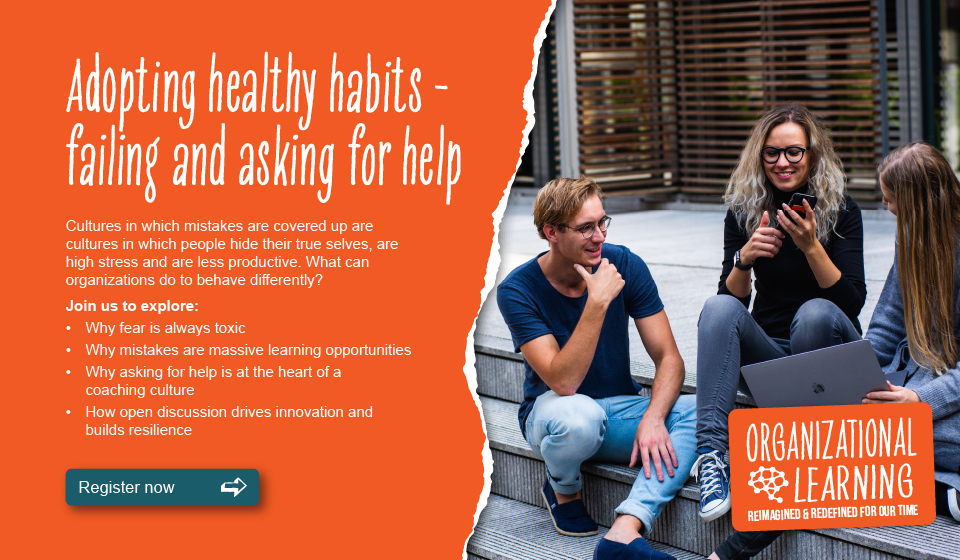
Adopting healthy habits: how to fail in order to learn and how to ask for help
In the final webinar in his Organizational Learning Reimagined and Redefined series Dr Nigel Paine is joined by Dr Andy Billings, senior partner at Future Ready and former head of Profitable Creativity at the video game company Electronic Arts to discuss the behaviours that create healthy, engaged learning organizations.
Fear at work is always toxic. Mistakes are massive learning opportunities. No one should be nervous about asking for help. At the heart of a healthy organization is the ability to ask for help. These are some of Dr Nigel Paine’s opening lines in his recent webinar, Adopting healthy habits: how to fail in order to learn and how to ask for help. The webinar was the latest in The Organizational Learning Reimagined and Redefined Series, where Paine has talked about the importance of organizational learning, as a strong complement to individual learning, and why organizations need to rethink their whole approach.
While the previous webinars talked about building the organizational brain and the need to embrace external insights to drive change, this one focused on the behaviours that create healthy, engaged learning organizations. Paine says asking for help needs to be viewed as a positive – when individuals ask for help it enables organizations to succeed, to learn, grow, innovate, adapt, be resilient…But, too often, asking for help is viewed as a weakness, an admission of failure, and so people don’t do it. And when people feel they can’t ask for help they tend to wear a mask. They pretend they know things when they don’t, they don’t ask for help when they should, and this behaviour has all sorts of serious consequences
Asking for help is at the heart of a learning culture. It’s how we all learn and encourage others to learn too.
Someone else who has a lot to say about healthy learning cultures is Dr Andy Billings, senior partner at Future Ready and former head of Profitable Creativity at the video game company Electronic Arts (EA). Billings was Paine’s guest speaker on the webinar and he talked about how he struck that balance between fostering creativity and innovation and meeting business demands. The two aims aren’t actually separate, but intertwined. Creativity and innovation drive business success, but only when failure is allowed and people can ask for help.
“My biggest and most important challenge has always been: how do I protect the fragile flame of creativity with its inherent unpredictability, whilst delivering the business needs of a public company that loves financial predictably?
To do this, I had to remove the fear of failure from the equation and build teams that shared their knowledge and helped each other grow in order to innovate constantly. I also had to create a culture that allowed everyone to have honest and productive conversations with their colleagues and banish product islands that put up fences and tried to repel all boarders. EA was full of healthy habits that supported what we did and helped build and sustain an environment where we could be successful again and again.”
At EA, Billings says everyone knew and accepted that failure was more common than success, but crucially, they didn’t view it as failure. “Setbacks, mistakes, mis-directions – however you want to call them – are a fact of life in the entertainment business.”
Billings say organizations (all organizations, not just those in the entertainment space) need to create the right environment for creativity and innovation to flourish, for new ideas and inventions to surface and be explored, continuously. “You can’t directly control innovation and you can’t directly control invention. You can create the environment for lots of ideas. And all of those ideas are not going to be successful. In fact, only a tiny, tiny percentage of them are going to be effective.”
When Billings says a tiny, tiny percentage, he means it –99.9% of ideas will not work out, he says, which is why it’s so important organizations create what he calls an ‘engine of new ideas’, to create the 0.1% that do.
It’s all about culture, a culture of learning, innovation, exploration and collaboration. At EA, when ideas didn’t work out, there was no stigma attached. It wasn’t failure, nobody felt ashamed. The idea hadn’t work and they moved on, taking their learning into new areas of exploration.
Innovation isn’t limited to creative industries or creative professionals. Organizations have to continually seek to innovate and improve at every level in today’s digital, disruptive world. During Billings’ time at EA, the organization went through digital transformation – from selling video games 100% through physical retail to just 10% physical retail and 90% digital. That meant distribution innovation, marketing innovation, logistics innovation…
This can only happen when organizations create the right environment. Paine says the starting point is not ‘creating a learning culture’ this is the end point when you change the culture in a workplace. Organizations need to be thinking about trust, empowerment and engagement, about having diverse teams where people learn together and challenge each other’s thinking, and about leadership. This environment fosters collaboration, sharing, the creation of ideas, decision making and a sense of purpose. “And when you’ve got all that, you’ve got the chance of a learning culture,” he says.
Watch the recording or to listen to the previous webinars here.


